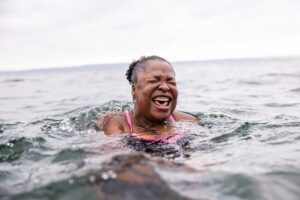
Research has shown that humans who are still living an ancestral, hunter/gatherer lifestyle do not experience the plethora of afflictions associated with reproductive dysfunction or menopause in the developed world, most probably due to relatively healthy metabolisms. When thinking about what would support our hormones, microbiome, and metabolism, at any age or stage, we might consider the differences in our diets and lifestyles. So, while we might not want to “throw the baby out with the bathwater” and go back to living without so many of our wonderful technological advances, we can still look to how our human and hominid ancestors lived for clues on how to prevent some of the degenerative conditions that are increasing in modernised humans. This is a big one, so hang on and let the games begin!

Ancestrally Living Humans
There are pockets of traditional humans left on earth, living and eating as they have for thousands of years. While they do not have access to our modern advances and healthcare in more immediate situations, they have very little degenerative disease or need for long-term pharmaceutical medications. Studies have shown that they have diverse and healthy microbiomes and well-functioning reproductive systems. They appear to achieve this by:
- consuming a nutrient-dense diet, focusing on animal foods
- experiencing deep connection to the earth and each other
- having supportive social and familial networks
- little to no exposure to EMFs, forever/toxic chemicals, or air pollution
- remaining active throughout life with lower overall stress
- daily exposure to natural light from the sun (with firelight at night)
- regular exposure to cold or heat
These lifestyle practices have been shown in scientific research to support human circadian rhythms, healthy metabolisms, balanced hormonal and reproductive function, sound sleep, redox potential, stress management, and naturally high “feel-good” hormones.
Part 2 – Exercise, Thermal Practices, EMFs and Pollution, and Stress
Exercise
We are at the point to say that some type of exercise in your day is essential…at any age. In fact, consistent activity throughout the day is more effective than sitting all day and then going to the gym for an hour. Studies show that regular activity and some higher-intensity exercise support the reduction of reproductive and hormonal issues, e.g., menopausal manifestations like temperature fluctuations and erratic mood, and microbiome and hormone balance. Muscle is now being looked at as a longevity organ and is linked to metabolic, heart, and bone health. Additionally, exercise can tend to support calming neurotransmitters. Three physiological changes after menopause are the loss of skeletal muscle and bone density and the gain of adipose tissue, particularly unhealthy visceral fat. There is a type of subcutaneous fat, the first layer of fat under the skin, that is metabolically healthy. This superficial subcutaneous fat is metabolically active, secreting beneficial hormones. Deeper subcutaneous fat is typically metabolically unhealthy, and visceral fat, especially when it grows inside organs, is very unhealthy.
Traditional humans continue to be active, gaining and maintaining a significant amount of lean muscle mass. So, even if they have subcutaneous fat tissue, some or most of it will be healthy superficial, brown/beige fat, and therefore they remain metabolically healthy—this has been shown to be healthier than having poor musculature with little to no body fat. A preventative strategy would be for women to focus on building and maintaining muscular power. There are all sorts of ways to achieve this. The younger you start, the better; however, any age is the perfect age to start resistance training, etc., and to see the benefits. Research has shown that resistance training (lifting weights) and jumping are key to bone health after menopause.

Another focus might be on exercise that decreases cortisol and other stress hormones. Just 20-30 minutes walking is enough to significantly drop cortisol levels. Traditional humans tend to do a lot of walking. Getting 10,000-12,000 steps per day, on average, of walking is linked to healthy weight and cardiovascular function. Pilates, gentle yoga, qi gong, thai chi, or other gentle movement can also be very useful in relieving stress. High intensity interval training (HIIT) has been shown to be a powerful healthy aging support for the heart and brain and targeted amounts of cardio are known to support repair and growth of brain cells, heart tissue, and lung function (VO2 max). Sprinting, for those that can handle it, has also shown benefit especially on supporting the reduction of visceral fat. A movement regimen that consists of plenty of walking with age-appropriate amounts of cardio and strength training, combined with balance and yoga-type exercises, might just do the trick. Throw in some HIIT if appropriate. While you’re at it, exercise outdoors and spend time barefoot on grass or sand, or swimming in the sea/lake/river, to get the benefits of natural light and being grounded to the earth. “Forest bathing” – being or walking in the bush or forest has been shown to support healthy stress and reproductive hormone levels.
Focused wisdom for:
- Teens and puberty: Any activity they like to engage in! Not everyone is super athletic, but we can all find some kind of “play” or exercise regimes we enjoy doing.
- Reproductive age: Exercise to create strength, flexibility, lean muscle mass, and balanced hormones. HIIT routines have been shown to support the heart and blood vessels in regard to age-related cardiovascular stiffening.
- Fertility: More of a focus on stress-relieving exercise but fairly similar to normal routine if healthy.
- Pregnancy: Research says pregnant women who remain active experience fewer issues with pregnancy and birth. Avoid contact sports and rough or stressful activities, of course!
- Menopause: Focus on safely keeping or building muscle mass for bone density and strength. Engage in activities that are joyful and playful to help with stress relief. Taking short walks after meals can support healthy weight. Do not fear intense, short duration exercise and weight training, as the benefits have been well studied, but please do so with supervision if advanced in age.
Thermal Practices

Traditional humans are exposed to extremes of heat and cold on a relatively regular basis. We evolved “shock” proteins that are released in response to the stress of the extreme heat or cold, which trigger a cascade of ultimately beneficial processes. This is known as hormetic stress, or “that which doesn’t kill you makes you stronger.” A growing body of research is finding a link between cold or heat exposure and healthier reproductive function and smoother menopause. Research tells us that 3 separate cold plunges in cold water totaling 11 minutes per week and 3 separate saunas totaling around 60 minutes per week is enough to see benefits in metabolism and fat composition.
It might seem counterintuitive to get in a sauna when you are experiencing hot flushes, but multiple research studies show saunas to be beneficial during perimenopause. Dry and/or infrared sauna has been shown to support internal temperature and sweat management, sound sleep, cardiovascular and joint comfort, healthy libido and weight, stress management, and a balanced mood in menopausal women. Sauna is generally thought of as higher than 75°C (approximately 170°F). Steam sauna does not appear to convey the same benefits, nor does infrared sauna. infrared exposure is beneficial, you simply need to separate out your beneficial infrared light exposure from your very hot sauna sessions (unless your infrared light can withstand the heat!).

On the cold end of the spectrum, emerging evidence suggests that regular cold plunging, or cryotherapy, may be supportive for hormone and reproductive function, stress and mood management, joint comfort, blood circulation and pressure, and increasing the amount of healthy “beige” fat (uncoupling the mitochondria in white adipose tissue) and decreasing the formation of damaging visceral fat around internal organs. Cold exposure has even been shown to support feelings of motivation by increasing dopamine levels for up to 6 hours. What constitutes “cold” water is generally taken to mean temperatures less than 15.5°C (approx. 60°F), even as low as 2-3°C, that result in a variety of hormetic stress responses in the body.
There is strong evidence to suggest that women do not experience the benefits that men do at temperatures below around 11-13°C (51.8-55.4°F) because the negative sympathetic nervous system response to extremely cold water is too strong in females. There are also monthly hormonal changes in the reproductive years that mean a cold plunge may be contraindicated at certain times of a women’s cycle (see Focused wisdom for: *Reproductive age). For women who wish to enjoy the benefits of cold exposure, a quick dip in sea or bath water that is around 11-16°C (51.8-60.8°F) is enough. It would seem that it was scientifically insightful for Jack to give Rose the piece of door frame to lie on at the end of Titanic!
A caveat would be that because these practices release stress hormones and trigger an immune response, it would be wise to check with a health practitioner before starting as to whether thermal therapy would be suitable for you. Cold plunging is best done at the start of the day. After 4-5 pm, your body is wanting to lower its temperature for sleep, so it will be harder for you to “heat up” and recover from cold exposure. Many people take 30-second to 2-minute blasts of cold water at the end of a shower, but, while beneficial, this does not appear to have quite the same cluster of effects, although it may be perfectly fine for females. Sauna seems to be most beneficial when exposure occurs later in the day and heat appears to be more beneficial than cold for most women. In any case, neither of these practices would be considered essential, unlike the other practices outlined in these articles; however, they can be fun and health-promoting if used in the right way for you. Always listen to your body.

Focused wisdom for:
- Teens and puberty: Sauna and cold plunging might not be de rigueur for our teens but they probably experience cold water swimming at times.
- *Reproductive age: Avoid cold plunging during ovulation and just prior to and during menstruation. Sauna during this time would be great.
- Fertility: Again, more of a focus on relieving stress, so limit or avoid cold plunging; perhaps more sauna, at a lower heat if you prefer. FYI, male fertility is enhanced more by cold than heat, as sauna can negatively impact sperm quality and cold exposure supports testosterone production. Couples who are trying to conceive may require opposite thermal therapies—Females, sauna; males, cold exposure.
- Pregnancy: If you already have a habit of thermal therapies, and are experiencing an uncomplicated pregnancy, do what feels right without stress. Studies show increasing heat through hot yoga, exercise, and low heat sauna are safe and beneficial during uncomplicated pregnancies. If you haven’t tried them before, perhaps it is not the best time to introduce them. If you are keen to try them, talk to your health provider first—go slow, avoid extremes of temperature, and be especially cautious with cold.
- Perimenopause: Watch for any signs of additional stress on your body and be mindful of what your cycle is doing (if you have one). If you have any health conditions, particularly with your heart, lung, or immune health, please check with a health professional first.
EMFs and pollution

Traditional humans tend to live in areas where there is no pollution, very little plastic use, and where there are little to no non-native electromagnetic frequencies from cell towers, etc. Some tribes have started to use cell phones, so things are changing for them quickly. But, for all intents and purposes, these things have had little influence on their physiology and health to date. Research shows us that air pollution is detrimental to our metabolism and hormones. Chemical exposure can alter physiological function and affect our hormones as well.
Studies are more mixed on the effect of EMFs; however, much of the research showing no adverse effects is done by vested interests, and many studies showing the opposite are not widely seen. On a cellular level, EMF exposure can cause cells to accumulate calcium and decrease exclusion zone water, affecting their ability to make energy and stay healthy. It is wise to use caution with cell phones and laptops, etc., when pregnant, with little ones, or when trying to conceive.
Plastics, perfumes, and other chemical-containing products are well-known to contain endocrine disruptors, such as BPA and phthalates, so limiting their use may also be wise. Research tells us that we may be ingesting (via food, water, air, and through our skin) micro and nanoplastics at the rate of about the size of a credit card worth of plastic molecules each week. Polyester, nylon, and acrylic clothing materials can be problematic for us, for our microbiome, and for our environment, as they are petroleum-based, plastic polymers.
Focused wisdom for:
- Teens and puberty: Help kids avoid plastics, and other chemical pollution, where possible. These things contain xenoestrogens, which can disrupt natural hormone signaling and have been associated with precocious (early onset) puberty.
- Fertility: Plastics, perfumes, household chemicals contain endocrine disruptors, so using natural alternatives will support fertility.
- Pregnancy: Growing fetuses are especially vulnerable to chemical, plastic, and EMF pollution. Don’t stress*; but do what you can to limit YOUR exposure so baby will be supported.
- Menopause: Another female life stage where exposure to xenoestrogens are hugely problematic. Limit where possible.
- All ages and stages benefit from an awareness of where toxic substances can be found and how to mitigate exposure. This can be an effortful and time-consuming endeavour, so maybe address these things when energy is high and stress is low.
- *Grounding and sunlight exposure can support the body and its cells to cope better with exposure to toxicity, as can diet (think animal proteins and fats) and stress management techniques.
Stress

We left the biggest until last… Stress. Chiefly emotional stress, but any stress on the body is a huge factor in hormonal health. In our modern lifestyle we are consistently in stressful situations—driving a car, working in an unnatural environment, pressure at work, economic pressure, multitasking, relationship problems, physical stress from poor diets, and more. Not often do we get a chance to “decompress.” The permanent state of the resulting fight-or-flight response without recovery periods is known as “learned helplessness.” This is signified by hormonal imbalances, metabolic dysfunction, oxidative stress, and other negative physiological changes, and a lack of motivation to change the situation.
Many hunter/gatherer-type people, living their traditional lives, when questioned about emotional or mental stress, speak of “not worrying about things.” Their focus is finding food and connecting with each other, and this does not generally create mental anguish among the tribespeople. At least those things are not perceived as stressful. Humans, and indeed other animals, are designed to be able to cope with stressful situations in short bursts—running from a threat or fighting an adversary. This changes our physiology dramatically, but then we return to normal relatively quickly. The trick is to learn to perceive daily events as simply just happening. This is also known as “acceptance.”
Something that has been shown to be very effective at supporting healthy stress levels is the practice of letting go of attachment to outcomes and seeing the reality of a situation. Meditation, mindfulness, and breathing techniques (breathwork) are examples of stress management practices and acceptance. These practices can also support the release of calming neurotransmitters like oxytocin and endorphins.
Breathwork is also very important for our general physiology—breath-holding is a great de-stressor, and it helps you maintain the carbon dioxide/oxygen balance in your tissues. Exercise at appropriate levels is very supportive, and just being in nature can be very calming. Another thing to consider is body and facial bone and soft tissue structures; points of tension and structural abnormalities can affect your ability to breathe well, both day and night. It is a good idea to check in with an experienced, holistic bodywork practitioner, particularly if you are unable to get control of symptoms like worry mind, muscle and joint discomfort, irritability, teeth grinding, lack of energy, etc.

Focused wisdom for:
- Teens and puberty: Research has shown young people benefit greatly from creating daily meditation and breathing practices. Set them up for life by guiding them with this.
- Reproductive age: Expanding things on a metaphysical level, perhaps. There are many types of stress-relief techniques. Try CO2/O2 balanced, diaphragmatic breathing, mindfulness, or meditation, and a stress-relieving movement routine like yoga or Qi gong. Rigorous exercise can also help with emotional stress. Find the ones that work for you.
- Fertility: Even more of a focus on relieving stress to facilitate conception. Expand to include letting go of stressful situations in your life. Most women say they found it easier to conceive when stress was low.
- Pregnancy and breastfeeding: Do whatever you have the time and energy for – simple breathing exercises may be your best friend.
- Menopause: During perimenopause, hormonal imbalances can occur, and cortisol can rise. These imbalances can contribute to weight gain, hormonal disruption, and cardiovascular and blood sugar imbalances. Meditation and breathwork has been shown in research to support healthy cortisol levels.
If you are at all concerned with any part of your reproductive and/or hormonal life, please see your GP or connect with a natural health professional to personalise your diet, lifestyle, and herbal supplements.
See Ancestral Wisdom for Female Hormonal Health, Part 1
And the rest of the Women’s Health Series:
The 3 Ms and the Female Hormonal Life Cycle, Part 1 – Menarche
The 3 Ms and the Female Hormonal Life Cycle, Part 2 – Menstruation
The 3 Ms and the Female Hormonal Life Cycle, Part 3 – Menopause
